Over the last few years, I've learned a lot about growing vegetable, herb, and flower starts indoors. The first few years I just put them under my dining room light and a lamp and wondered why they were so spindly and weak looking. Why they often times died. Then I realized that they must not be getting enough light.
We have a grow store nearby that sells lighting, plant food, light stands, trays, and more for growing plants indoors. A good amount of it is targeted to marijuana growing (which is legal in my state), but is also excellent for growing your seedlings indoors.
Lighting setup
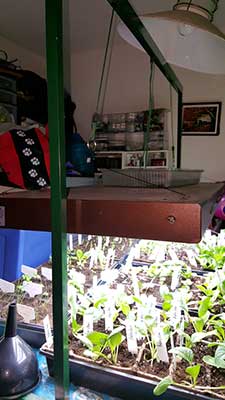 I went in and talked to an employee and explained what I was doing. They sold me a Hydrofarm 4' light that has 6 tubes as well as a 4' Jump Start stand that can hold the light. This pretty much covers my entire dining room table, even when I have in the leaf. I absolutely love this light. It is amazing the difference between when I was just growing them under a lamp and when I got a real grow light. The plant grow stronger, bigger, and faster than under just a plain old light.
I went in and talked to an employee and explained what I was doing. They sold me a Hydrofarm 4' light that has 6 tubes as well as a 4' Jump Start stand that can hold the light. This pretty much covers my entire dining room table, even when I have in the leaf. I absolutely love this light. It is amazing the difference between when I was just growing them under a lamp and when I got a real grow light. The plant grow stronger, bigger, and faster than under just a plain old light.
This will be the third growing season that I've used the lamp and stand. They've served me well. And when we had an issue with some of the connectors breaking on the stand, Jump Start sent me new ones at no charge. Excellent company and I love their products. Thus far I have not had to replace any of the bulbs and I have my light on about 12 hours a day for a few months. I haven't noticed much of an increase in our electricity from them, either.
This year I decided to increase the amount of seedlings I can grow at a time, so I purchased a heavy duty shelf at Home Depot, some chains and s-biners to hang the lights, and some more 4' grow lights. I originally planned to do one light per shelf for 3 of the shelves, so I bought three lights. But after hanging them, I realized that I wasn't getting quite as much light as I might like when the lights were down low, so I decided two lights per shelf might be best. So I went ahead and set it up that way. I currently have two shelves covered and will be purchasing two more sets to do a third shelf. The other two shelves are being used for storage, such as seeding soil, trays, tray lids, and pots.
Each shelf can hold 4.5 trays. I have a few of the little in the window trays I bought a while back, and those are right at half the size of a regular tray, so they work great. I'm actually using both the lid and the tray as trays, so that allows me to fill up more space. So between the shelves I'm currently using and the table I have about 17 trays worth of seedlings going right now.
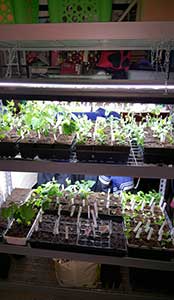
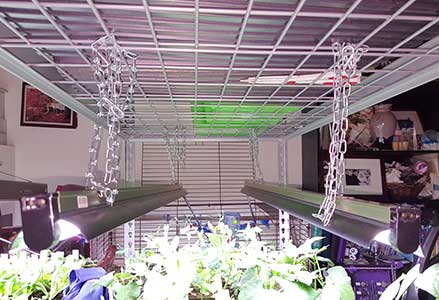
So that I don't have to remember to turn the lights on/off at the right time, I bought a timer that does this for me. It's specially made for growing indoors, so it has two settings - bloom and grow. With bloom the lights are on for 12 hours per day, while with grow they are on for 16 hours. I just tell it what time I want the lights to come on and it does the rest from then on. I believe I can also create my own setting, but I find these two are all that I need. I picked this up at my local grow store, Grow World.
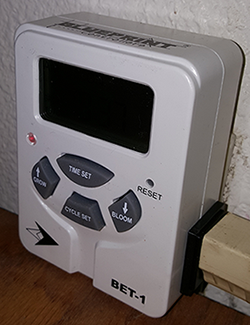
Seedling soil
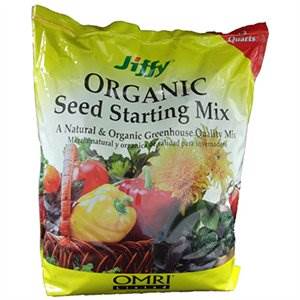 At first I was using a seedling soil by Miracle Gro, as it was the only thing I found in the stores. However, a lot of people don't like using their products because it's not organic. That meant I didn't sell as many of my extra seedlings.
At first I was using a seedling soil by Miracle Gro, as it was the only thing I found in the stores. However, a lot of people don't like using their products because it's not organic. That meant I didn't sell as many of my extra seedlings.
Two years ago, though, I had a hard time finding it in the store and instead found a larger bag by another company that was indeed organic. I tried it and since then I haven't used anything else. It's called Jiffy Organic Seed Starting Mix. Ever since I started using it, my seedlings have grown so much better than they ever did in the past. Best part is that it's right around $5 for a 12 quart bag, which is less than I was paying for a smaller bag of the other stuff.
It's taken me about 6 bags worth of this to do the 17 trays that I have out right now. The nutrients that are in the soil do a really good job of lasting until the plants are ready to be transplanted in the ground, which means you don't need to add any nutrients while they're growing - just water and lights. Which is even more money saved.
I'm hoping to find it somewhere in bulk so that I can buy larger quantities of it at a lower price, but right now I just run to the feed store, Home Depot, etc. and pick up bags as I need them.
Pots and trays
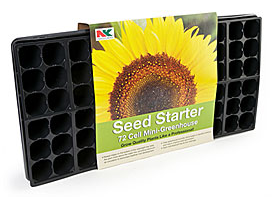 I use a variety of pots while I am growing my seedlings. I start out with the small cell ones where there are 6 cells to a block and 12 blocks fit in a tray. This is a good size for starting them, as it allows for a lot of plants to be started at once. The cells have holes in the bottom to allow the roots to reach the water that you put in the bottom of the tray.
I use a variety of pots while I am growing my seedlings. I start out with the small cell ones where there are 6 cells to a block and 12 blocks fit in a tray. This is a good size for starting them, as it allows for a lot of plants to be started at once. The cells have holes in the bottom to allow the roots to reach the water that you put in the bottom of the tray.
Once the plants get larger, I move them up to bigger pots. Plants that will be pretty large as seedlings, such as beans, peas, tomatoes, peppers, and eggplant get moved up to pots that are about 3.5"x3.5" at the top and about 4" tall. Ones that won't get as large as seedlings, such as greens, go into peat pots that are about 2.5"x2.5" and 2.5" tall. This gives them more room to grow and the peat pots can be put right into the ground.
Some plants, though, I will leave in those smaller cell planters and transplant directly from there. This includes root vegetables like onions, which prefer not to be transplanted a lot since it damages their roots.
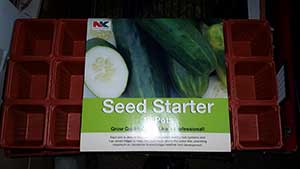 I had been buying these one seed starter pots where 18 of them fit in the same space as 72 of the smaller ones. Last year I invested a bunch of money into them, probably buying a dozen or more sets. Then I couldn't figure out what was wrong and why my plants weren't growing right. Turns out that they completely forgot to put the holes in the bottom of the pots, so all the water I was pouring into the bottom of the tray wasn't doing anything at all - the plants couldn't get any water. I tried and tried to get NK Lawn & Garden to replace them, but all I got was the run-around. When they did finally send me something in the mail, it was a pack of small peat pots and some seeds. Nothing compared to the money I had spent on faulty pots. I ended up having to carefully snip holes in them myself so that my plants could grow properly. This year I have refused to buy any of them even though they appear to have fixed the issue.
I had been buying these one seed starter pots where 18 of them fit in the same space as 72 of the smaller ones. Last year I invested a bunch of money into them, probably buying a dozen or more sets. Then I couldn't figure out what was wrong and why my plants weren't growing right. Turns out that they completely forgot to put the holes in the bottom of the pots, so all the water I was pouring into the bottom of the tray wasn't doing anything at all - the plants couldn't get any water. I tried and tried to get NK Lawn & Garden to replace them, but all I got was the run-around. When they did finally send me something in the mail, it was a pack of small peat pots and some seeds. Nothing compared to the money I had spent on faulty pots. I ended up having to carefully snip holes in them myself so that my plants could grow properly. This year I have refused to buy any of them even though they appear to have fixed the issue.
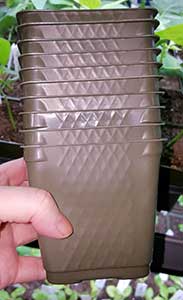 Instead this year I bought a bunch of pots from Amazon. For $20 (and free shipping since I'm a Prime member), I got 150 pots of approximately the same size. Pretty good deal seeing as I was paying about $6 for a tray with 18 pots. If I need trays, I can get them for about a buck at the store. That means I pay about 20 cents per pot (with tray) as compared to about 36 cents. I got them for so cheap because I buy the "factory seconds" ones, which means they're the ones at the bottom of the case that gets a little squished. There's absolutely nothing wrong with them other than them being a little bent and such - no breakage or anything. In fact, when I opened up the case I would have never guessed they were factory seconds. You can find the regular ones for about $40 for the 150 pots or click on the link for the "used" ones and that will take you to the factory seconds (they're not actually used, it's just how they are classified). Even at the regular price it's still cheaper than the other ones I bought.
Instead this year I bought a bunch of pots from Amazon. For $20 (and free shipping since I'm a Prime member), I got 150 pots of approximately the same size. Pretty good deal seeing as I was paying about $6 for a tray with 18 pots. If I need trays, I can get them for about a buck at the store. That means I pay about 20 cents per pot (with tray) as compared to about 36 cents. I got them for so cheap because I buy the "factory seconds" ones, which means they're the ones at the bottom of the case that gets a little squished. There's absolutely nothing wrong with them other than them being a little bent and such - no breakage or anything. In fact, when I opened up the case I would have never guessed they were factory seconds. You can find the regular ones for about $40 for the 150 pots or click on the link for the "used" ones and that will take you to the factory seconds (they're not actually used, it's just how they are classified). Even at the regular price it's still cheaper than the other ones I bought.
And then I bought a bunch of peat pots online as well to use for all my greens. I like them because they are easy to pop apart in order to fit them into various sized trays and around other packs of cells or pots. I may end up ordering another pack of these this year.
When it comes to trays, I'm not too picky. As long as they seem fairly stable, are the correct size, and have no holes, I'm good with them. I especially like those that are one seamless area, as then I can pour water into one corner and it'll fill the entire tray. The ones that came with those NK pots have individual holes for each pot, which kind of defeats the entire purpose since you have to remove almost every pot in order to water the plants.
- Log in to post comments













